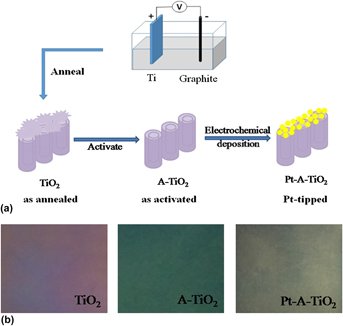Crossref Citations
This article has been cited by the following publications. This list is generated based on data provided by
Crossref.
Mao, Zhou
Lin, Hua
Xu, Meng
Miao, Jie
He, Shijie
and
Li, Qing
2018.
Fabrication of co-doped CdSe quantum dot-sensitized TiO2 nanotubes by ultrasound-assisted method and their photoelectrochemical properties.
Journal of Applied Electrochemistry,
Vol. 48,
Issue. 2,
p.
147.
Liu, Xinghang
Hou, Baofei
Wang, Gang
Cui, Zhenqi
Zhu, Xiang
and
Wang, Xianbao
2018.
Black titania/graphene oxide nanocomposite films with excellent photothermal property for solar steam generation.
Journal of Materials Research,
Vol. 33,
Issue. 6,
p.
674.
Li, Yuxin
Fu, Rong
Wang, Xiangdong
and
Guo, Xiaoling
2018.
Preparation of core–shell nanostructured black nano-TiO2 by sol–gel method combined with Mg reduction.
Journal of Materials Research,
Vol. 33,
Issue. 24,
p.
4173.
Yu, Chengtao
Zhang, Jingyi
Yang, Hexu
Zhang, Ling
and
Gao, Yu
2019.
Enhanced photovoltaic conversion efficiency of a dye-sensitized solar cell based on TiO2 nanoparticle/nanorod array composites.
Journal of Materials Research,
Vol. 34,
Issue. 07,
p.
1155.
Li, Changxin
Liu, Yan
Zhang, Yanzong
Long, Lulu
Shen, Fei
Yang, Gang
Zhang, Xiaohong
He, Yan
Wang, Lilin
and
Deng, Shihuai
2019.
Electro-assisted ammonium persulfate activation to promote the introduction of N and S into TiO2 film: Enhancing its photoelectrocatalytic performance under solar.
Journal of Materials Research,
Vol. 34,
Issue. 20,
p.
3573.
Gonçalves, Bruno S.
Silva, Lucas M.C.
de Souza, Tarcizo C.C.
de Castro, Vinícius G.
Silva, Glaura G.
Silva, Bruno C.
Krambrock, Klaus
Soares, Renata B.
Lins, Vanessa F.C.
Houmard, Manuel
and
Nunes, Eduardo H.M.
2019.
Solvent effect on the structure and photocatalytic behavior of TiO2-RGO nanocomposites.
Journal of Materials Research,
Vol. 34,
Issue. 23,
p.
3918.
Zhan, Feng
Xiong, Lei
Liu, Fang
and
Li, Chenying
2019.
Grafting Hyperbranched Polymers onto TiO2 Nanoparticles via Thiol-yne Click Chemistry and Its Effect on the Mechanical, Thermal and Surface Properties of Polyurethane Coating.
Materials,
Vol. 12,
Issue. 17,
p.
2817.
Sołtys-Mróz, Monika
Syrek, Karolina
Pierzchała, Joanna
Wiercigroch, Ewelina
Malek, Kamilla
and
Sulka, Grzegorz D.
2020.
Band gap engineering of nanotubular Fe2O3-TiO2 photoanodes by wet impregnation.
Applied Surface Science,
Vol. 517,
Issue. ,
p.
146195.
Khezami, Lotfi
Lounissi, Imen
Hajjaji, Anouar
Guesmi, Ahlem
Assadi, Aymen Amine
and
Bessais, Brahim
2021.
Synthesis and Characterization of TiO2 Nanotubes (TiO2-NTs) Decorated with Platine Nanoparticles (Pt-NPs): Photocatalytic Performance for Simultaneous Removal of Microorganisms and Volatile Organic Compounds.
Materials,
Vol. 14,
Issue. 23,
p.
7341.
Yurdakal, Sedat
Çetinkaya, Sıdıka
Özcan, Levent
Gök, Özer
and
Palmisano, Leonardo
2021.
Partial photoelectrocatalytic oxidation of 3-pyridinemethanol by Pt, Au and Pd loaded TiO2 nanotubes on Ti plate.
Catalysis Today,
Vol. 380,
Issue. ,
p.
248.
Navidpour, Amir H.
Hosseinzadeh, Ahmad
Zhou, John L.
and
Huang, Zhenguo
2023.
Progress in the application of surface engineering methods in immobilizing TiO2 and ZnO coatings for environmental photocatalysis.
Catalysis Reviews,
Vol. 65,
Issue. 3,
p.
822.
Hajjaji, M. A.
Missaoui, K.
Trabelsi, K.
Bouzaza, A.
Bessais, B.
Hajjaji, A.
and
Assadi, A. A.
2024.
Electrodeposited Platinum Nanoparticles on Highly Ordered Titanium Dioxide Nanotubes for Photocatalytic Application: Enhancement of Photocatalytic Degradation of Amido Black Dye.
Catalysis Letters,
Vol. 154,
Issue. 3,
p.
1242.
